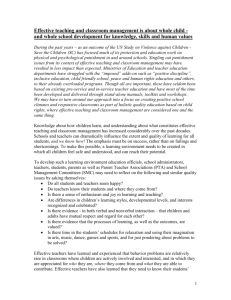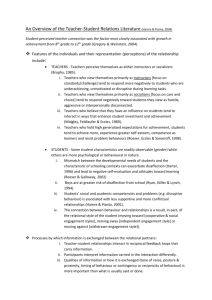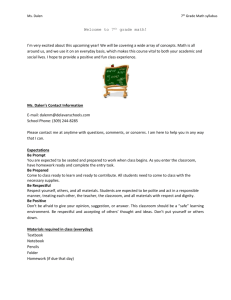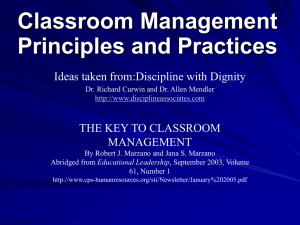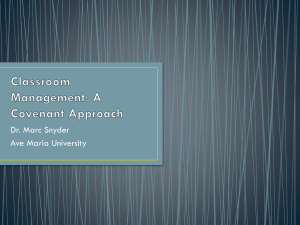when measuring teacher-student relationships. The STRS was
advertisement
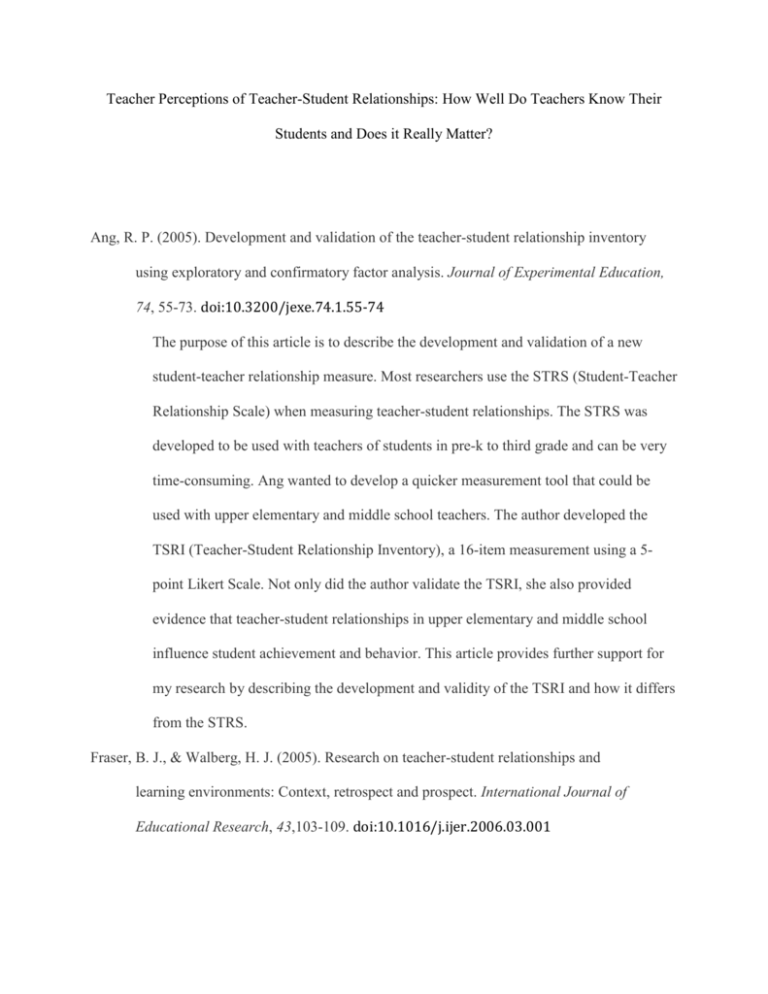
Teacher Perceptions of Teacher-Student Relationships: How Well Do Teachers Know Their Students and Does it Really Matter? Ang, R. P. (2005). Development and validation of the teacher-student relationship inventory using exploratory and confirmatory factor analysis. Journal of Experimental Education, 74, 55-73. doi:10.3200/jexe.74.1.55-74 The purpose of this article is to describe the development and validation of a new student-teacher relationship measure. Most researchers use the STRS (Student-Teacher Relationship Scale) when measuring teacher-student relationships. The STRS was developed to be used with teachers of students in pre-k to third grade and can be very time-consuming. Ang wanted to develop a quicker measurement tool that could be used with upper elementary and middle school teachers. The author developed the TSRI (Teacher-Student Relationship Inventory), a 16-item measurement using a 5point Likert Scale. Not only did the author validate the TSRI, she also provided evidence that teacher-student relationships in upper elementary and middle school influence student achievement and behavior. This article provides further support for my research by describing the development and validity of the TSRI and how it differs from the STRS. Fraser, B. J., & Walberg, H. J. (2005). Research on teacher-student relationships and learning environments: Context, retrospect and prospect. International Journal of Educational Research, 43,103-109. doi:10.1016/j.ijer.2006.03.001 QTI, Questionnaire on Teacher Interaction, is the topic of this article. Fraser and Walberg described the measurement and review some of the studies that have used QTI. The QTI is used internationally in research on teacher-student relationships and the learning environment. Previous research using the QTI has been completed on students with disabilities, both in inclusion and resource classes. The article also reiterated the point that studies involving the QTI have replicated an empirical link between teacher-student relationships and student achievement, as well as behavior. This article discussed the QTI and the research in practical terms, making it very easy to understand. I will use the information on the QTI and past studies using the QTI to help me determine which measurements I will use for my study. Fumoto, H. (2011). Teacher-child relationships and early childhood practice. Early Years: An International Journal of Research and Development, 31, 19-30. doi: 10.1080/09575146.2010.535790 Fumoto’s study is the first qualitative study on teacher-student relationships that I have read. It should be noted that the author did use the Student-Teacher Relationship Scale (STRS) to categorize his questioning. The intent of the author is to observe and interview two classroom teachers to reveal how teachers interact with children and what are the teachers’ experiences? Fumoto hopes that by revealing the characteristics of an effective teacher, more professional development can be used to train teachers and retain teachers. His rationale for this study is threefold. First, there is a need to document teachers’ experiences to understand the value of their expertise. One third of early childhood teachers leave the profession each year and the turnover is four times higher than those who teach older students. Second is the need to document how experienced teachers interact with students and expose them to rich experiences. This is an issue in the United States as early childhood pedagogy is being challenged by more rigorous standards of learning. Third, there is a need to utilize effective, experienced teachers in professional development by valuing their practices. In a time of financial strain, many schools are not utilizing professional development opportunities. The author recommends more collaborative planning, peer observations, and meaningful professional development. I would like to combine the qualitative aspects of the study with quantitative data on a much larger group of participants. Hamre, B. K., & Pianta, R. C. (2001). Early teacher-child relationships and the trajectory of children's school outcomes through eighth grade. Child Development, 72, 625-638. doi: 10.1111/1467-8624.00301 Hamre and Pianta’s study is based on the assumption that the teacher-student relationship in kindergarten can predict future student problems or success. This hypothesis is based on previous research that produced evidence of the significance of the teacher-student relationship on student achievement and behavior. Their study followed a sample of 179 kindergarten students to eighth grade by studying grades, standardized test scores, discipline records, and work-habits. They found that relational negativity in teacher-student relationships resulted in negative academic and behavioral outcomes in eighth grade. This work, like most of the studies on teacherstudent relationships, is based on the attachment theory. The Teacher-Child Rating Scale (TCRS) was used in this study and was given in May of the kindergarten year. The kindergarten teachers also took the STRS (Student-Teacher Relationship Scale) in May of the students’ kindergarten year. Not only does this study inform me of another teacher-student relationship measurement, but it also gives me an idea of how to do the data analysis using correlations and regressions. This article is considered to be the standard of research on teacher-student relationships. It was conducted under the authorization and support of the Office of Educational Research and Improvement and the United States Department of Education. It is also interesting that the author includes his address and e-mail, which I have planned to use as a resource. Hughes, J., & Kwok, O. (2007). Influence of student-teacher and parent-teacher relationships on lower achieving readers' engagement and achievement in the primary grades. Journal of Educational Psychology, 99, 39-51. doi:10.1037/0022-0663.99.1.39 Referencing previous studies on teacher-student relationships, Hughes and Kwok hypothesize that there are gender and racial disparities in teacher-student relationships. Their second hypothesis is that teacher-student relationships influence academic motivation and engagement. Finally, the authors propose that academic engagement and motivation account for the quality of academic achievement. First grade teachers, students, and parents of the students participated in this study. Of particular interest to me were the measurements used for the study. For academic achievement, the researchers used the Woodcock-Johnson III. Child engagement was measured using a portion of the Conscientious scale of the Big Five Inventory. For teacher-student relationships, the Teacher Relationship Inventory (TRI) was given to the teachers. Teachers also completed a perception questionnaire on parent involvement. Finally, of most interest to me, the students were surveyed by asking them to select students in the classroom to participate in a class play. Students were asked to select classmates that liked to talk to their teachers and that the teachers enjoyed spending time with. I thought this was a very interesting method of gaining the students’ perceptions of which students the teachers liked and didn’t like. In the conclusion, the article stated that teachers should have more professional learning on developing teacher-student relationships if we are ever going to close the achievement gap. The authors also suggest that this study be replicated with other subjects to further publicize and make administrators aware of the importance of positive teacher-student relationships. Klem, A. M., & Connell, J. P. (2004). Relationships matter: Linking teacher support to student engagement and achievement. Journal of School Health, 74, 262-273. doi:10.1111/j.1746-1561.2004.tb08283.x The authors, Klem and Connell, are both researchers for the Institute for Research and Reform in Education. This study was performed using a reduced model of a study conducted by Connell in 1991. Connell’s study explained the linkages between a student’s experiences in social context, their self-esteem, their patterns of action, and their outcomes of academic performance when compared to teacher-student relationships. For the purpose of this study, Klem and Connell asked the following research questions: 1) What threshold levels on teacher support and engagement are critical to later academic success? 2) How much difference does achieving the threshold levels contribute to the likelihood of school success or failure? 3) How effective is the First Things First school-reform model in improving levels of teacher support and 4) What are its affects on student engagement and achievement? I found this study particularly interesting and relative to my proposed study. Not only did this study give me ideas for measurement tools and data analysis methods, but it also gave me information of the school-reform model, First Things First. First Things First (FTF) is a reform initiative developed by the Institute for Research and Reform in Education. FTF helps create personalized learning environments by creating small learning communities (SLC’s) and incorporates high-quality, standards-based teaching and learning. After reading this article, I intend to further investigate the reform model, First Things First. The authors stated that an independent study was being conducted at the time of their study. I am anxious to read the findings of this independent study to see if it correlates with the study by Klem and Connell. Maldonado-Carreno, C., & Votruba-Drzal, E. (2011). Teacher-child relationships and the development of academic and behavioral skills during elementary school: A within- and between-child analysis. Child Development, 82, 601-616. doi: 10.1111/j/14678624.2010.01533.x The data from the study in this article is taken from the National Institute of Child Health and Human Development (NICHD) Study of Early Child Care. The authors’ goal of their study is to examine whether the quality of teacher-student relationships is associated with academic and behavioral changes through fifth grade. The authors chose to do this longitudinal study due to fact that most of the research on teacherstudent relationships had been conducted on kindergarten and first grade teacherstudent relationships. The authors proposed that empirical evidence proves that teacher-student relationships weaken as students get older. Some of the reasons for this include that the teacher is more focused on academics rather than nurturing, class size is larger, and students often change classes as they get older. For these reasons, the authors chose to do a longitudinal study of students from kindergarten to fifth grade. The authors also suggest that previous research had methodological limitations by relying entirely upon between-child comparisons. Maldonado-Carreno and VotrubaDrzal suggest that within-child associations between teacher-student relationship quality and student functioning are a way to reduce the threat of omitted variables caused by between-child comparisons. The researchers found that some of their research was inconsistent with previous research on teacher-student relationships. The other studies did not include a control for initial differences in standardized achievement scores. They concluded the associations between teacher-student relationships and standardized academic achievement may not be due to higher quality teacher-student relationships, but rather due to the students’ own intellectual abilities, the quality of instruction, or rater bias. This research study encouraged me to think deeply about all of the variables, both observed and unobserved that may have an affect on teacher-student relationships. Saft, E. W., & Pianta, R. C. (2001). Teachers' perceptions of their relationships with students: Effects of child age, gender, and ethnicity of teachers and children. School Psychology Quarterly, 16, 125-41. Retrieved from http://www.apa.org/pubs/journals/spq/index.aspx In this study, Saft and Pianta, examine the relation between teachers’ perceptions of their relationships with their students compared to teacher ethnicity, child age, child ethnicity, and gender using the Student-Teacher Relationship Scale (STRS). Questions for the STRS are derived from the attachment theory. Pianta is considered to be an expert in the field of teacher-student relationships and is referenced in many research studies and articles. The data in this study were analyzed using four separate regression analyses. I found this article relevant to my research as it is based on the attachment theory and the authors used the STRS for measurement of teacher-student relationships. The extensive reference list is both useful and informative. I intend to read more about the attachment theory in order to better understand its meaning and relevance to my topic. Spilt, J. L., & Koomen, H. Y. (2009). Widening the view on teacher-child relationships: Teachers' narratives concerning disruptive versus nondisruptive children. School Psychology Review, 38, 86-101. Retrieved from http://www.nasponline.org/publications/spr/sprissues.apx The authors of this article are Jantine Spilt, a doctoral candidate in special education at the University of Amsterdam, and Helma Koomen, an assistant professor at the University of Amsterdam. The goal of their research is to validate the narrative measurement, Teacher Relationship Interview (TRI), by comparing it to the wellvalidated measure, the Student-Teacher Relationship Scale (STRS). The authors felt that the STRS, which is in questionnaire form, taps mainly into cognitive thinking. In contrast, the TRI captures unconscious thoughts of teachers. The article emphasizes the importance of positive teacher-student relationships, which is based on Bowling’s attachment theory. The research in this article is relevant to my study as it describes two methods of measurement of teacher-student relationships and the components of each. Teven, J. J., & McCroskey, J. C. (1997). The relationship of perceived teacher caring with student learning and teacher evaluation. Communication Education, 46, 1-9. doi:10.1080/03634529709379060 Teven and McCroskey, the authors of this article hypothesize that it is not how much a teacher cares or IF she cares about the student, but it is more important that she be “perceived” as caring. Earlier research by McCroskey indicated that empathy, understanding, and responsiveness lead students to believe the teacher is caring. Therefore, their research questions were: 1) Are teachers that are perceived to be more caring evaluated more positively by their students? 2) Do students who perceive their teacher as more caring evaluate the course content more positively? 3) Do students who perceive their teacher as caring report to have learned more? Their study was based on the Aristotelian theory of a positive relationship between perceived ethos and other positive attitudes toward a source. The data was analyzed by computing simple correlations between scores for perceived caring and those for teacher evaluation and both affective and cognitive learning. All three hypotheses were proved to be true. The authors of this study gave many suggestions for future studies and also gave another theory for the value of teacher-student relationships. I will use this information to do further research and perhaps add another indicator to my study.
